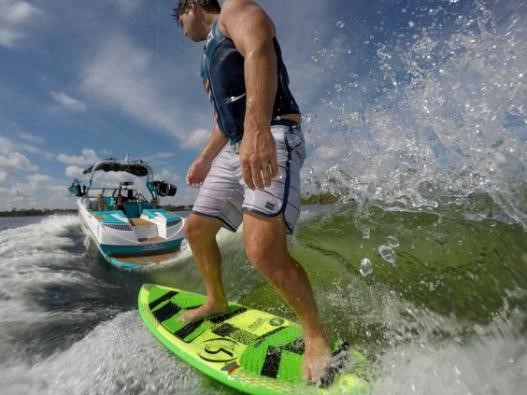Outdoor News
Bill Moritz, Wildlife Management Institute
December 15, 2023

Legislation (LRB 5069/1) was recently introduced in Wisconsin to provide protection against wake sports activities in Wisconsin lakes. Wake boats are specially designed boats that create large wakes to allow recreationists to enjoy wake boarding and wake surfing. The larger wakes also may impact aquatic environments, shoreline erosion and private property, and public safety. The use of water as a ballast may also have the unintended consequence of spreading aquatic invasive species (AIS).
Wakeboard boats also known as wake boats, surfboats, or tow boats are designed to create a large, specially shaped wake for a wakeboarder to jump the wakes from side to side doing aerial tricks. Some wake boats make waves so large that they can be surfed without a tow rope, like waves in an ocean. Generally speaking, wake board specific boats are V-drive boats. This means they are an inboard boat with the engine placed backwards in the rear of the boat. This is done to keep more weight in the back of the boat and make the wake larger. Most wakeboard boats will have several features that help to create large wakes. These include ballast, hydrofoil, and hull technology. Ballast is a simple term for weight. When wakeboard boats have ballast tanks, it means that they have room for extra weight to weigh the boat down for larger wakes. Water from the lake is often used to provide the necessary ballast.
A study sponsored by the Water Sport Industry Association (WSIA) provides one of the most comprehensive and direct investigations of wake boat waves (Goudey and Girod, 2015). The study documents a maximum wave height for wake surfing of approximately 30” and about 20” for wakeboarding. Online searches indicate that newer designs may create larger waves than this study reported. Comparatively, the authors documented a wave height of 14” when the same vessel was “cruising” (i.e. no water sports). Maximum wave energy for wake surfing was approximately 2,500 joules/meter (J/m) and 850 J/m for wakeboarding as compared to 305 J/m for cruising. Importantly, the study notes the rapid decrease in wave energy for wake surfing and wakeboarding activities as the waves progress away from the boat track and toward the shore indicating that the farther away from the shore these activities take place, the lower the transfer of wave energy that occurs on the shoreline. In addition, when these activities occur more than 300’ from shore, the wave energy is about equal (400 J/m) to cruising 150 to 200’ from shore.
The design of wake boats may affect aquatic environments by resuspending sediments, increasing transfer of total phosphorous and orthophosphate into the water column, and increasing oxygenation (Raymond and Galvez 2015). However, many lake attributes likely contribute to the effect of wake boats, making application to various lake bodies more challenging.
Shoreline erosion is defined as the removal of sediments of a variety of shapes and sizes. Wave energy is a result of wave height and frequency (periodicity). Thus, shorelines that endure larger and more frequent waves are subjected to higher energetic forces and consequently more erosive power. Under natural conditions, windward shorelines tend to become adapted to wave action and are composed of larger rocks and boulders, thus are more resistant to erosion. In contrast, areas that are protected from prevailing winds or have a relatively short fetch (distance over which wind travels) are more sensitive and tend to be comprised of smaller sediment particles. Along the same lines, the vegetative composition of windswept shorelines tends to be comprised of large trees with extensive root systems that provide extra erosive protection while areas protected from the wind tend to be dominated by vegetation that is more sensitive to wave action.
Mercier-Blais and Prairie (2014) evaluated the impacts of waves created by wake boats in Lake Memphremagog and Lake Lovering in Quebec, Canada. They compared wave energy (turbulent kinetic energy, TKE) transferred to steeply and gradually shaped shorelines, finding that waves reaching the banks of shores with steep shoreline contained significantly more energy than those that reached shallow shorelines and thus had more erosive force. In contrast, the energy in waves that travel over shallower water tend to break, thus dissipating their energy toward the lake bottom.
Very large wakes present a risk for fishing boats, canoes, kayaks, sailboats, paddleboards, swimmers, and water skiers if the other recreationist isn’t prepared for the passing of a large wake.
Ballast compartments in wake boats and tow boats, filled with up to 1,000 pounds of water, help create the large waves needed to wake surf or wakeboard. The ballast compartments are typically drained when not in use and are always drained prior to trailering. It is difficult to clean and drain ballast water compartments because as they are currently designed, they do not drain completely and risk spreading AIS. Incomplete draining can lead to the harboring of viable aquatic invasive plants or animals, some of which are as small as a grain of sand and remain viable for several days.
Lakes have been an attraction for residents and tourists for decades. The water draws those who wish to fish, paddle, cruise, and participate in active water sports. The popularity of activities is constantly changing. The non-motorized vessel of choice went from the canoe to the kayak to the stand-up paddle board, and the motorized vessel has evolved from a runabout, or water ski boat, to a multi-use tow boat. Regulations will need to be adapted if new water recreation types create new challenges for lake management.
Photo Credit
Active Water Sports, Flickr
|
